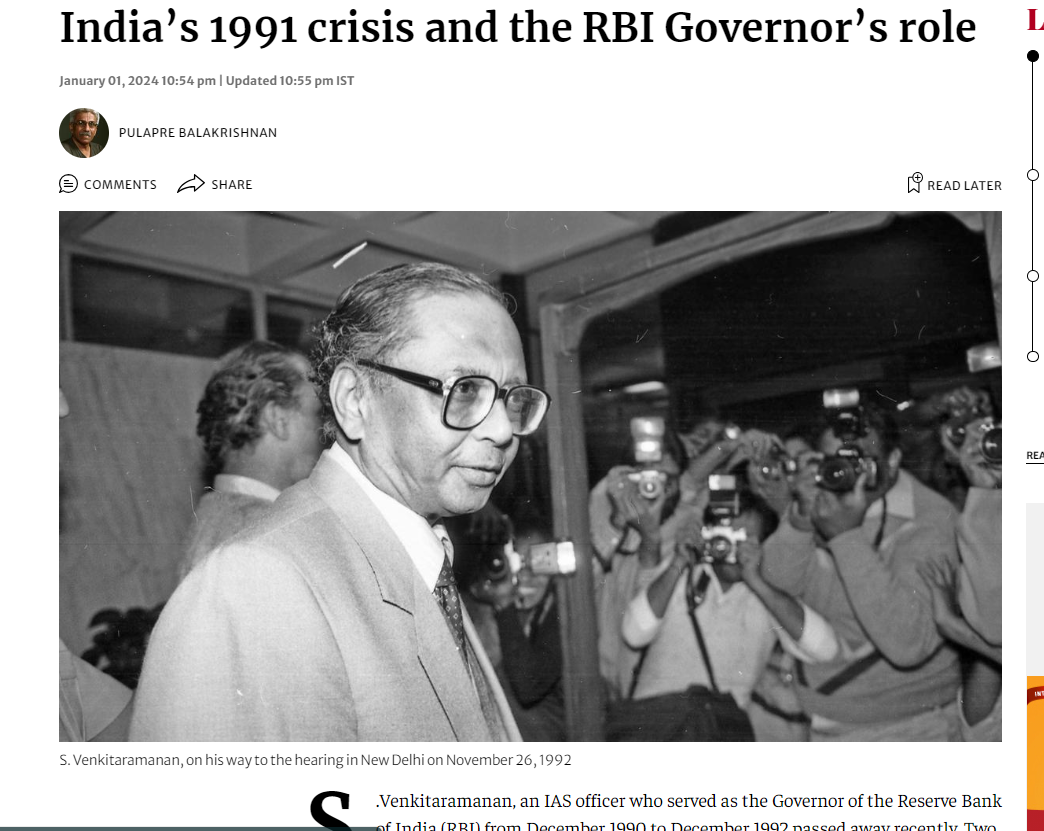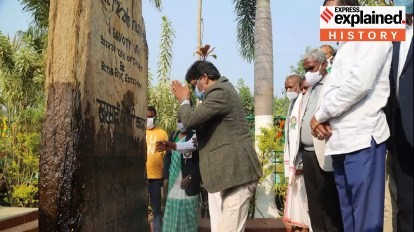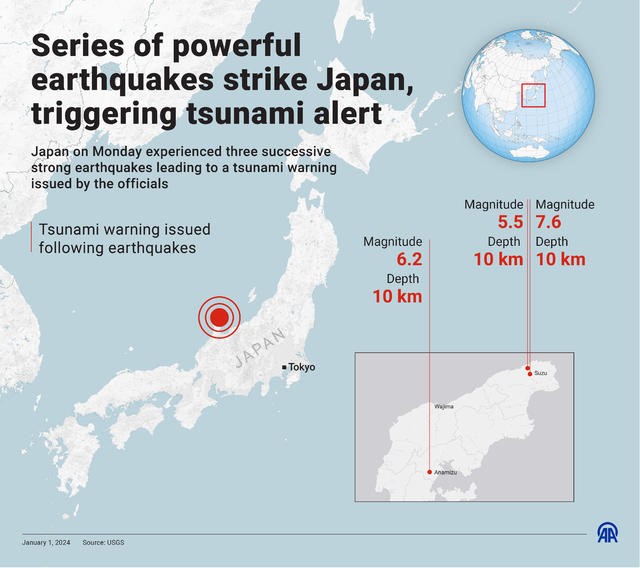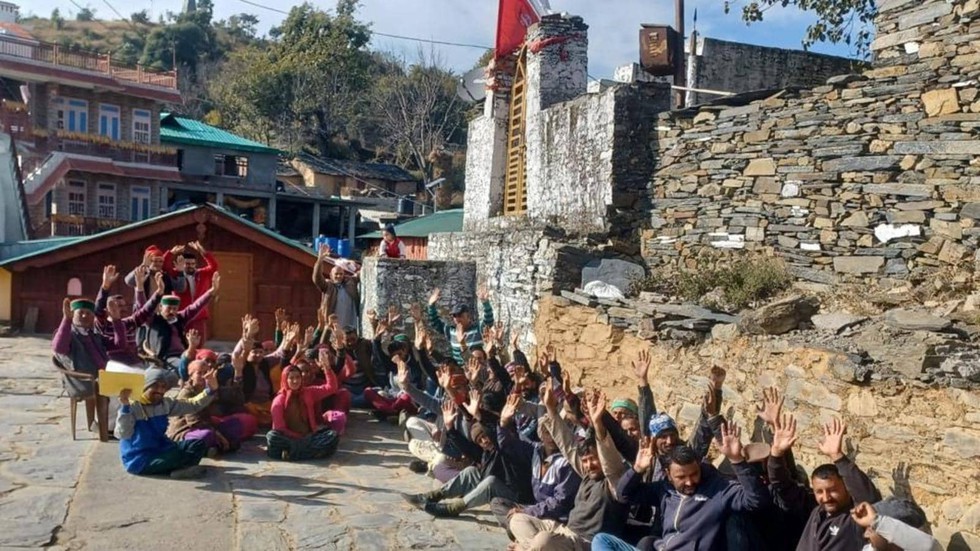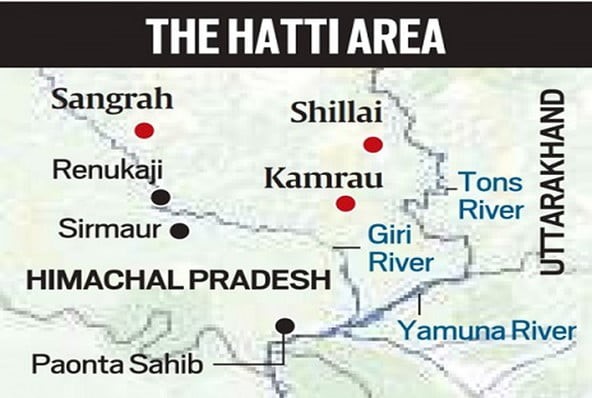The RBI Governor's Role in the 1991 Crisis in India
Context:
The passing of S. Venkitaramanan, the former Governor of the Reserve Bank of India (RBI), signifies the conclusion of a period marked by substantial contributions. His legacy is notable for pivotal interventions during India’s economic crises and a dedication to open dialogue and inventive policies.
Addressing the Balance of Payments Crisis
- In the economic turmoil of 1990, India encountered a severe balance of payments crisis arising from diminished remittances and escalating oil prices.
- Under Venkitaramanan’s leadership, the RBI implemented bold measures, such as committing gold reserves, to prevent a default on international payments. Although criticized domestically, this strategy played a crucial role in upholding India’s global credibility and financial stability.
Contribution to Economic Reforms
- Venkitaramanan introduced an import compression program, significantly reducing the current account deficit.
- These measures laid the groundwork for subsequent economic reforms led by the Narasimha Rao government and Dr. Manmohan Singh.
Challenges and Controversies
- Despite his significant accomplishments, Venkitaramanan’s tenure faced challenges, notably the Harshad Mehta securities scandal, which overshadowed his earlier successes.
- The public perception tends to overlook his role in navigating India through economic challenges.
Noteworthy Openness and Inclusivity
- Renowned for his receptivity to diverse opinions, Venkitaramanan engaged with economists and critics alike.
- His innovative approach to policy-making, considering varied perspectives, contributed to more inclusive and effective economic policies.
Legacy in the RBI and Beyond
- Venkitaramanan’s vision led to the establishment of the Development Research Group, fostering collaboration between the RBI and independent economists.
- His belief in relying on India’s intellectual resources continues to influence the RBI’s approach, despite persistent challenges like inflation management.
In Conclusion
- Venkitaramanan’s term as RBI Governor was characterized by bold decisions and a commitment to intellectual openness.
- While facing challenges, his role in safeguarding India’s economy and promoting a culture of dialogue and research within the RBI constitutes a significant part of his enduring legacy.
His approach to economic policy and management serves as an inspiration for current and future leaders in the field.
The 1948 Kharsawan Massacre: A Tragic Chapter in Jharkhand's History
Context:
On January 1, 1948, the town of Kharsawan in present-day Jharkhand experienced a tragedy reminiscent of the Jallianwala Bagh massacre in 1919, as the police opened fire on a crowd gathered for a protest and the weekly market, resulting in the deaths of hundreds, if not thousands, of Adivasis.
Background of Kharsawan Massacre:
Since the establishment of the Bihar and Orissa Province in 1912, the Adivasis in the region had been advocating for a separate state, reflecting their unique culture and addressing their grievances. This demand gained momentum, with the Simon Commission recognizing the distinct nature of the region in 1930. In 1938, the Adivasi Mahasabha, led by prominent leader Jaipal Singh Munda, was formed to further this cause.
Controversy over Kharsawan’s Merger:
In 1947, Kharsawan, a princely state with a significant Odia-speaking population, decided to merge with Orissa during India’s princely states’ integration. However, the majority of Adivasis opposed this merger, preferring a separate state.
The Massacre Incident:
On January 1, 1948, a large gathering convened in Kharsawan to protest the merger, coinciding with the weekly market day. Over 50,000 people assembled, anticipating the presence of Jaipal Munda, who did not arrive. The tense atmosphere prompted the Orissa military police to open fire, resulting in a massacre. The exact number of casualties remains unclear, with estimates ranging from a few dozen to several thousand.
Aftermath and Legacy:
The aftermath saw bodies disposed of in a well and the jungle, with many injured left untreated. The incident remains a dark and unresolved chapter in Indian history. Official records state 35 deaths, but alternative sources suggest numbers as high as 2,000. No definitive report or accountability for the massacre has been established. A memorial in Kharsawan serves as a reminder of this tragedy, with political leaders often visiting to pay their respects.
Conclusion:
The Kharsawan massacre serves as a poignant reminder of the complexities and tragedies during India’s transition to independence, particularly for marginalized communities like the Adivasis. It highlights the unresolved issues of tribal rights and recognition in India’s history.
Central Japan is struck by an Earthquake and Tsunami
Primary Concept
On January 1, 2024, Ishikawa prefecture in Japan experienced a 7.5-magnitude earthquake that resulted in tsunami waves exceeding one meter in height.
Geographical Sensitivity of Japan
- The susceptibility of Japan to environmental and disaster challenges is significantly influenced by its geographical characteristics, particularly in terms of plate tectonics.
- The nation’s strategic location at the intersection of multiple major tectonic plates renders it highly prone to seismic activities. A comprehensive examination of how plate tectonics contributes to Japan’s geographical vulnerability reveals the following:
Plate Convergence Zones:
- Pacific Ring of Fire: Japan is situated in the Pacific Ring of Fire, an area known for heightened seismic activity due to the presence of various tectonic plate boundaries.
- Involved Plates: The primary tectonic plates engaging near Japan include the Pacific Plate, the Philippine Sea Plate, the Eurasian Plate, and the North American Plate.
- Subduction Zones: The Pacific and Philippine Sea plates undergo subduction beneath the Eurasian and North American plates. This subduction process emerges as a significant source of seismic activity, giving rise to potent earthquakes and volcanic eruptions.
Seismic Activity:
- Frequent Earthquakes: The constant movement of these plates results in a frequent occurrence of earthquakes, with Japan experiencing numerous tremors annually, ranging from minor to catastrophic.
- Major Earthquakes: Historical incidents such as the 2011 Great East Japan Earthquake and the 1995 Great Hanshin Earthquake underscore the potential for extensive destruction and loss of life attributed to Japan’s tectonic conditions.
Tsunami Threat:
- Tsunami Generation: Earthquakes beneath the sea or along the coastline can displace substantial water volumes, leading to the formation of tsunamis. The 2011 tsunami, triggered by a massive undersea earthquake, caused widespread devastation and the Fukushima nuclear disaster.
- Coastal Vulnerability: Japan’s expansive coastline heightens its susceptibility to tsunamis, which can arrive shortly after an undersea earthquake, leaving minimal time for evacuation.
Volcanic Events:
- Volcanic Eruptions: The subduction of the Pacific and Philippine Sea plates not only induces earthquakes but also contributes to noteworthy volcanic activity. The ascent of magma resulting from the subducted plate’s melting leads to volcanic eruptions.
- Active Volcanoes: With over 100 active volcanoes, Japan faces direct consequences from its tectonic positioning. Eruptions pose risks to nearby communities, impacting air travel and local economies.
Geological Complexity:
- Fault Intersections: The interaction among multiple tectonic plates forms a intricate network of faults, amplifying the unpredictability and diversity of seismic events.
Diverse Seismic Phenomena: This intricacy manifests in various seismic phenomena, including deep-focus earthquakes, occurring at greater depths and affecting more extensive areas.
Empowering the Hatti community and advancing initiatives for economic growth in Himachal Pradesh
Context:
The Himachal Pradesh government has taken substantial measures to address the longstanding request for conferring Scheduled Tribes (ST) status to the Hatti community in the Transgiri region of Sirmaur district. Additionally, the government has initiated various programs to stimulate economic growth within the state.
Granting ST Status to Hatti Community:
- The Hatti community, residing in the Transgiri area’s 154 panchayats in Sirmaur district, has persistently sought ST status.
- This decision by the government aligns with the approval of the Constitution (Scheduled Tribes) Order (Second Amendment) Bill, 2023, and subsequent notification by the President on August 4, 2023.
- The implementation delay was a result of the state government seeking clarification from the Centre.
Need for Granting ST Status:
- The demand for ST status by the Hatti community mirrors the recognition accorded to the JaunsarBawar area of Uttarakhand in 1967.
- Despite similarities in social, cultural, and geographical aspects between Hatti and Jaunsari communities, the Transgiri area had been excluded.
- The recent decision rectifies this historical injustice, fulfilling a commitment made to the Hatti community.
About Hatti Community of Himachal Pradesh:
- The Hatti community in the Transgiri area of Sirmaur district possesses a distinctive cultural and historical background.
- Their quest for ST status originates from the aspiration for fair representation and socioeconomic empowerment.
- The recent notification bestowing Scheduled Tribes status represents a noteworthy milestone in their pursuit of acknowledgment.
Initiatives for Economic Growth:
- The state Cabinet has launched Phase 2 of the Rajiv Gandhi Swarozgar StartUp Yojna.
- This initiative is designed to provide loans and encourage individuals aged between 21 to 45 years to engage in businesses related to the establishment of solar power plants.
- The scheme, with a focus on capacities ranging from 100 kW to 500 kW, aligns with the state’s renewable energy targets.
- This move is expected to generate self-employment opportunities and contribute to economic growth among the youth.
The Cabinet has also approved the ‘Sarkar Gaon Ke Dwar’ program, scheduled from January 8 to 12, to be conducted across the state.
Psychoanalysis
Context:
The individual involved in the breach of Parliament security recently underwent a psychological analysis to gain insights into their mental state and potential motivations for the incident.
Regarding Psychoanalysis:
- Psychoanalysis is a therapeutic approach and theory that entails the examination of dreams, exploration of free association, and analysis of the transference and resistance between therapist and patient.
- It is a form of talk therapy designed to address mental health issues by delving into the relationship between unconscious and conscious elements of psychological experiences.
- Founded on the belief that everyone harbors unconscious thoughts, feelings, desires, and memories.
- Emphasizes the significance of early childhood experiences and the concealed operations of the unconscious mind.
- Sigmund Freud (1856—1939) is acknowledged as the pioneer of psychoanalysis.
He posited that the unconscious could be accessed through dreams, free association, and verbal slips.

